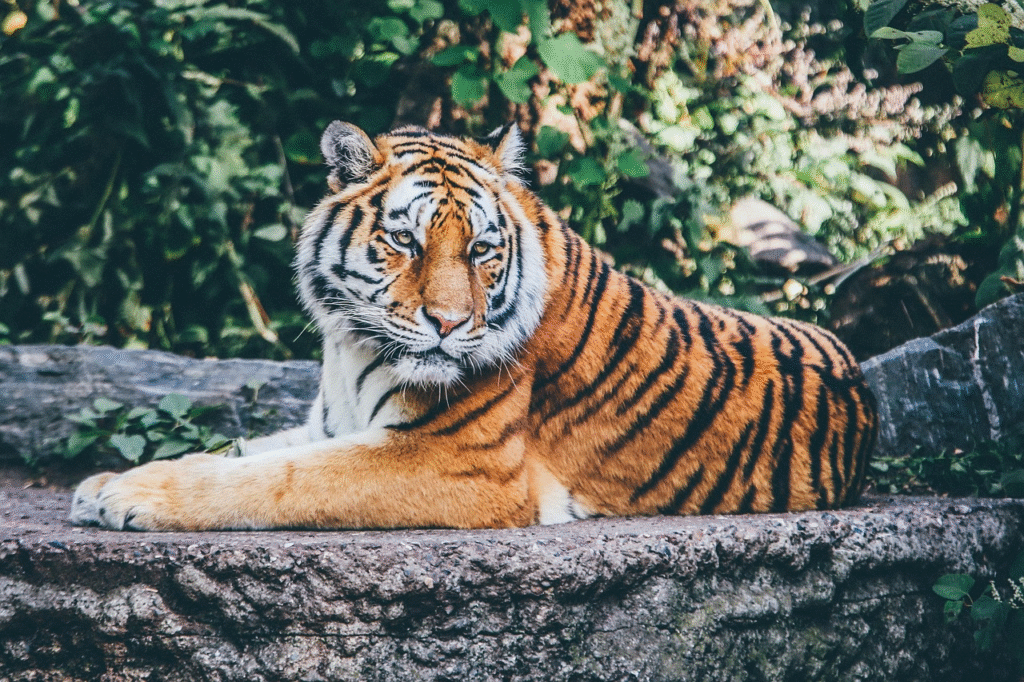India has designated 17 national symbols to serve the identity of the nation. These 17 National symbols stand for the rich cultural heritage and natural diversity of the country. Furthermore, the symbols reflect patriotism and instill pride in every Indian. Chosen over time with much care, these symbols point out India’s distinct plants, animals, and historical traditions significantly.
National Symbols Of India: List
India is home to a diverse range of national symbols with deep cultural and historical meaning certainly. Further, these symbols reflect the nation’s pride and identity. Accordingly, we have made this section for you, to introduces you to the National Identity Elements of India. Prior to the patriotism, these symbols are intrinsic to the Indian identity and heritage. Here, we look at the complete list of the 17 national symbols of India representing its varied traditions and values.
| Sl. No. | Title | Symbol |
| 1 | National Flag | Tiranga |
| 2 | National Animal | Royal Bengal Tiger |
| 3 | National Bird | Indian Peacock |
| 4 | National Aquatic Animal | Ganges River Dolphin |
| 5 | National Anthem | Jana Gana Mana |
| 6 | National Song | Vande Mataram |
| 7 | National River | Ganga |
| 8 | National Emblem | Lion Capital of Ashoka |
| 9 | National Tree | Indian Banyan |
| 10 | National Calendar | Saka Calendar |
| 11 | National Currency | Indian Rupee |
| 12 | National Reptile | King Cobra |
| 13 | National Heritage Animal | Indian Elephant |
| 14 | National Flower | Lotus |
| 15 | National Fruit | Mango |
| 16 | National Vegetable | Pumpkin |
| 17 | Oath of Allegiance | National Pledge |
National Symbols of India
1. National Flag – Tiranga
The Constituent Assembly adopted the National Flag of India in its present form on 22nd July 1947. It served as the national flag of the Dominion of India between 15 August 1947 and 26 January 1950 and that of the Republic of India thereafter. In India, the term “tricolour” or “tiranga” refers to the Indian national flag.
The National flag of India is a horizontal tricolor of deep saffron (kesari) at the top, white in the middle and dark green at the bottom in equal proportion. The ratio of width of the flag to its length is two to three. In the centre of the white band is a navy blue wheel which represents the chakra. Its design is that of the wheel which appears on the abacus of the Sarnath Lion Capital of Ashoka. Its diameter approximates to the width of the white band and it has 24 spokes.
Colours of the Flag
In the national flag of India the top band is of Saffron colour, indicating the strength and courage of the country. The white middle band indicates peace and truth with Dharma Chakra. The last band is green in colour shows the fertility, growth and auspiciousness of the land.
The Chakra
This Dharma Chakra depicted the “wheel of the law” in the Sarnath Lion Capital made by the 3rd-century BC Mauryan Emperor Ashoka. The chakra intends to show that there is life in movement and death in stagnation.
Source:- https://knowindia.india.gov.in/my-india-my-pride/indian-tricolor.php
Some legal provisions related to the national flag of India are :- The Flag Code of India, 2002, The Prevention of Insults to National Honour Act, 1971
2. National Animal – Royal Bengal Tiger
The magnificent tiger, Panthera tigris is a striped animal. It has a thick yellow coat of fur with dark stripes. The combination of grace, strength, agility and enormous power has earned the tiger its pride of place as the national animal of India. Out of eight races of the species known, the Indian race, the Royal Bengal Tiger, is found throughout the country except in the north-western region and also in the neighbouring countries, Nepal, Bhutan and Bangladesh. To check the dwindling population of tigers in India, the Government of India has launched ‘Project Tiger‘ in 1973. So far, the Government of India established 27 tiger reserves in the country under this project.
Source:- https://knowindia.india.gov.in/national-identity-elements/national-animal.php

3. National Bird – Indian Peacock
The Indian peacock, the national bird of India, is a colourful, swan-sized bird, with a fan-shaped crest of feathers, a white patch under the eye and a long, slender neck. The male of the species is more colourful than the female, with a glistening blue breast and neck and a spectacular bronze-green tail of around 200 elongated feathers. The female is brownish, slightly smaller than the male and lacks the tail. The elaborate courtship dance of the male, fanning out the tail and preening its feathers is a gorgeous sight.
Source:- knowindia.india.gov.in
4. National Aquatic Animal – Ganges River Dolphin
Dolphins are one of the oldest creatures in the world along with some species of turtles, crocodiles and sharks. The Ganges river dolphin was officially discovered in 1801. Further, ganges river dolphins once lived in the Ganges-Brahmaputra-Meghna and Karnaphuli-Sangu river systems of Nepal, India, and Bangladesh. But the species is extinct from most of its early distribution ranges.
Source:- worldwildlifefund
5. National Anthem – Jana Gana Mana
Jana Gana Mana, composed by Rabindranath Tagore, is India’s National Anthem. It was adopted in 1950. Sung in 52 seconds, the Bengali words honor India’s unity in diversity. They significantly invoke rivers, mountains, and cultural diversity. The anthem is sung at national functions and instills patriotism and solidarity.Further, its poetic appeal for harmony and development resonates well with people, symbolizing India’s spiritual and national pride. It is a strong reminder of the country’s collective dreams.
6. National Song – Vande mataram
The song Vande Mataram, composed in Sanskrit by Bankimchandra Chatterji, was a source of inspiration to the people in their struggle for freedom. Also, it has an equal status with Jana-gana-mana. He included this poem in his Bengali novel “Anandamath” back in 1882. It was first sung by Rabindranath Tagore in 1896 during an Indian National Congress session. On January 24, 1950, India’s constituent assembly officially adopted this song as the national song of India.
7. National River – Ganga
The Ganga, declared India’s National River in 2008, is a spiritual as well as ecological lifeline. It originates in the Himalayas and runs 2,525 km, sustaining millions of individuals. Moreover, it is worshipped as Goddess Ganga in Hinduism, symbolizing purity and salvation. Its cultural and environmental value displays India’s heritage. Conservation initiatives such as Namami Gange ensure its sanctity and reflect the country’s devotion to ecological balance and spiritual respect.
8. National Emblem – Lion Capital of Ashok
The State Emblem is an adaptation of the Lion Capital of Asoka at Sarnath. In the original, there are four lions, mounted back to back, on a circular abacus, which itself rests on a bell-shaped lotus. Further, the frieze of the abacus has sculptures in high relief of an elephant, a galloping horse, a bull and a lion separated by intervening Dharma Chakras.
On January 26, 1950, India adopted the profile of the Lion Capital as its State Emblem, showing three lions mounted on the abacus with a Dharma Chakra in the centre, a bull on the right, a galloping horse on the left, and outlines of Dharma Chakras on the extreme right and left. Later, the authorities omitted the bell-shaped lotus from the emblem. In addition, the motto Satyameva Jayate, which means ‘Truth Alone Triumphs’, written in Devanagari script below the profile of the Lion Capital is part of the State Emblem of India
Source:- knowindia.india.gov.in
9. National Tree – Indian Banyan
The Indian Banyan, which is India’s National Tree, symbolizes immortality and resilience. Its sprawling branches and aerial roots significantly represent interconnectedness.Moreover, it is celebrated in mythology and culture and serves as a gathering place for communities, providing shade and shelter. Found throughout India, it showcases hospitality and ecological importance. Otherwise, the banyan’s lasting presence reflects India’s unity and cultural richness, emphasizing its natural heritage..
10. National Calendar – Saka Calendar
The national calendar based on the Saka Era, with Chaitra as its first month and a normal year of 365 days was adopted from 22 March 1957 along with the Gregorian calendar for the following official purposes:
1. Gazette of India.
2. News broadcast by All India Radio.
3. Calendars issued by the Government of India.
4. Government communications addressed to the public.
Dates of the national calendar have a permanent correspondence with dates of the Gregorian calendar, 1 Chaitra falling on 22 March normally and on 21 March in leap year.
| National Calendar (Saka Calendar) | |
| Months | Dates |
| Chaitra | 21st March – 20th April |
| Vaishakha | 21st April – 21st May |
| Jyeshtha | 22nd May – 21st June |
| Ashadha | 22nd June – 22nd July |
| Shravana | 23rd July – 22nd August |
| Bhadra | 22nd August – 22nd September |
| Became | 23rd September – 22nd October |
| Kartika | 23rd October – 21st November |
| Agrahayana | 22nd November – 21st December |
| Pausha | 22nd December – 20th January |
| Magha | 21st January – 19th February |
| Phalguna | 20th February – 20th/21st March |
Source:- india.gov.in
11. National Currency – Indian Rupee (₹)
The symbol of Indian Rupee typifies India’s international identity for money transactions and economic strength. The Indian Rupee sign is an allegory of Indian ethos. The symbol is an amalgam of Devanagari “Ra” and the Roman Capital “R” with two parallel horizontal stripes running at the top representing the national flag and also the “equal to” sign. In addition, the Indian Rupee sign was adopted by the Government of India on 15th July, 2010.
Further, the symbol, conceptualised and designed by Udaya Kumar, a post graduate in Design from Indian Institute of Technology Bombay, has been chosen from thousands of concept entries received by the Ministry of Finance through an open competition among resident Indian nationals. Also, the process of establishing and implementing this new identity is underway through various digital technology and computer applications.
Source:- knowindia.india.gov.in
12. National Reptile – King Cobra
The King Cobra, National Reptile of India, embodies power and mystery. However, the longest venomous snake in the world, an inhabitant of Indian forests, is worshiped in mythology. Its olive green colour and hooded appearance are symbolic. Representing its ecological significance, it brings forth the message of biodiversity and conservation. Moreover, the King Cobra embodies the natural and cultural wealth of India, evoking admiration.
13. National Heritage Animal – The Indian Elephant
Also, the Indian Elephant, named National Heritage Animal in 2010, symbolizes wisdom and strength. Revered in festivals and mythology, it’s integral to India’s cultural fabric. The animal lives in forests and holds high priority in conservation efforts. Further, its gentle yet powerful presence reflects India’s heritage and commitment to protecting wildlife, embodying national pride.
14. National Flower – Lotus
On the other hand, the Lotus, India’s National Flower, symbolizes purity and resilience.Blooming pristinely in muddy waters, the lotus symbolizes the ability to overcome adversity. In addition, it holds sacred significance in Hinduism and Buddhism, where it is associated with deities like Lakshmi Its pink petals embody beauty and spirituality.Furthermore, the lotus represents India’s cultural depth and unity, inspiring spiritual growth.
15. National Fruit – Mango
Mango, the national fruit of India, is native to the country and often referred to as the ‘Food of the Gods.’ Indians have cultivated mangoes since time immemorial. Further, in ancient times, many renowned poets praised the deliciousness of this fruit The great Mughal emperor Akbar had planted about 1,00,000 mango trees in Lakhi Bagh in Darbhanga. India is known to be the largest producer of Mango and accounts for more than 50% of total mango being exported around the World.
16. National Vegetable – Pumpkin
Pumpkin is the National Vegetable of India, chosen for its widespread cultivation and the vital role it plays in Indian diets. Moreover, this versatile vegetable is grown across the country with minimal resources.
17. Oath of Allegiance – National Pledge
Pydimarri Venkata Subba Rao wrote the National Pledge in 1962, and it is a patriotic oath that is chanted in schools. It promotes accountability and pride by highlighting equality, solidarity, and commitment to India’s advancement.In addition, tts lyrics, which represent India’s democratic spirit and cultural unity, encourage a shared dedication to national principles.
Significance of National Symbols of India
India’s 17 national symbols represent its identity, heritage, and aspirations, unifying its diverse people. Their significance includes:
- Sovereignty and Unity: The Tiranga and Lion Capital represent national pride and integrity, reflecting India’s sovereignty.
- Patriotism and Harmony: Jana Gana Mana and Vande Mataram instill unity and devotion, inspiring collective pride.
- Cultural Heritage: Lotus, Banyan, and Indian Elephant showcase spiritual strength and cultural depth, based on mythology..
- Biodiversity and Conservation: The Royal Bengal Tiger, Indian Peacock, and Ganges River Dolphin highlight ecological diversity and conservation goals.
- Economic and Temporal Identity: Further, the Rupee sign (₹) and Saka Calendar symbolize economic development and astronomical legacy.
- Agricultural Abundance: The Mango and Pumpkin denote India’s agrarian heritage, part of cuisine as well as festivities.
- Civic Responsibility: Together with the National Pledge enforces equality and commitment towards national development.
In conclusion, these symbols reflect India’s ideals of strength, truth, and endurance, which inspire generations to feel proud and responsible.










